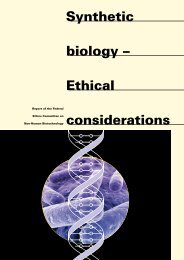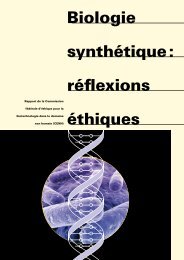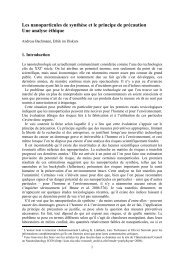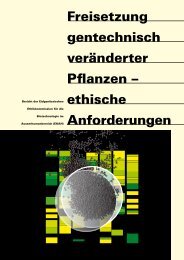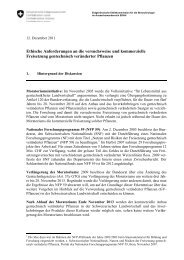Helmut Segner Fish Nociception and pain A biological perspective
Helmut Segner Fish Nociception and pain A ... - EKAH - admin.ch
Helmut Segner Fish Nociception and pain A ... - EKAH - admin.ch
- No tags were found...
You also want an ePaper? Increase the reach of your titles
YUMPU automatically turns print PDFs into web optimized ePapers that Google loves.
egions, thalamus, brain stem? Could it be that the integrated<br />
action of these regions are sufficient to generate a “simple” <strong>pain</strong><br />
sensation? Is the fact that <strong>pain</strong> perception in man is not an<br />
exclusive function of the cortex, but arises from the integrated<br />
activity of the <strong>pain</strong> matrix involving neocortical as well as<br />
non-neocortical regions supportive to such an interpretation?<br />
This leads also to the question on the evolution of <strong>pain</strong> perception:<br />
Has <strong>pain</strong> evolved only with the advent of the neocortex,<br />
with zero perception before presence of the neocortex, but full<br />
<strong>pain</strong> perception once the neocortex has evolved? Or was there a<br />
more gradual evolution of <strong>pain</strong>-related emotions <strong>and</strong> sensations,<br />
starting as a simple <strong>pain</strong> experience mediated by phylogenetically<br />
older brain regions?<br />
• the neocortex is a particular evolutionary feature of the mammalian<br />
vertebrates. Other vertebrate classes have taken different<br />
routes of brain evolution. Could it be that those vertebrate<br />
classes which possess no neocortex utilize other brain areas<br />
for functions which in mammals are executed by the neocortex<br />
(Ch<strong>and</strong>roo et al. 2004a, Huntingford et al. 2006, EFSA 2009)?<br />
The generation of <strong>pain</strong> sensation in the human brain involves a<br />
complex <strong>pain</strong> matrix, which comprises not only cortical areas but<br />
also subcortical <strong>and</strong> brainstem regions, or, as formulated by Craig<br />
(2009):<br />
“The anterior cingulate cortex certainly does not operate autonomously.”<br />
While Rose does not negate this fact, his view is that the subcortical<br />
areas alone, in the absence of the higher integrative system such<br />
as the neocortex, are not able to generate <strong>pain</strong> sensation. According<br />
to Rose (2002), brainstem <strong>and</strong> subcortical regions may be able<br />
to modulate perceptive processes in the cortex, but they cannot<br />
perform the perceptive process alone, without cortex. Rose (2002)<br />
supports his view from observations on humans with cerebral cortex<br />
destruction or congenital cortex deficits. These persons are<br />
believed to be in a vegetative state in which all conscious awareness<br />
of environmental stimuli is abolished. Importantly, these persons<br />
still show behavioural responses to <strong>pain</strong> such as withdrawal reaction<br />
or facial expressions. Since they have no neocortex function,<br />
Rose (2002) considers these responses as reflexive, stereotyped<br />
behaviours. However, this interpretation is partly in conflict to<br />
findings from patients with frontal lobotomy or cingulotoma. Until<br />
the 1950s, this surgery was sometimes done with patients who<br />
suffered from chronic <strong>pain</strong> or depression. Indeed, removal of the<br />
frontal cortex or the cingulate cortex was able to remove chronic<br />
<strong>pain</strong> <strong>and</strong> depression, under retainment of the general intelligence<br />
of the patients. However, they lost emotional depth <strong>and</strong> feeling<br />
(Hurt <strong>and</strong> Ballantine 1974). The patients retained normal <strong>pain</strong> reflexes,<br />
they were aware of the <strong>pain</strong>, but they did not experience the<br />
emotional feeling of <strong>pain</strong>, the reaction was entirely in the present,<br />
<strong>and</strong> they seemed to have lost fear of the <strong>pain</strong> (Freeman <strong>and</strong> Watts<br />
1950). Obviously, removing the frontal cortex does not completely<br />
eliminate <strong>pain</strong> perception but eliminates certain qualities of<br />
<strong>pain</strong> perception. This interpretation is supported by the findings<br />
of Schnakers <strong>and</strong> Zasler (2007). These authors measured neuronal<br />
activities in patients with no functional cortex. Upon nociceptive<br />
stimulation, neural activities in the subcortical regions of decorticate<br />
patients were not zero, but there were still rudimentary activities<br />
on-going. Patients with a minimally functional neocortex<br />
showed brain activation patterns which were similar to brain activation<br />
patterns of control subjects. Schnakers <strong>and</strong> Zasler (2007)<br />
interpret these observations not as indication that <strong>pain</strong> perception<br />
is impossible without neocortex, as claimed by Rose (2002), but<br />
their conclusion is that full <strong>pain</strong> perception depends on the interaction<br />
between cortical <strong>and</strong> subcortical regions. Also Duncan <strong>and</strong><br />
Barett (2007) emphasize that <strong>pain</strong> perception in man involves the<br />
integrated activity of multiple regions from neocortex, subcortex<br />
<strong>and</strong> brainstem, <strong>and</strong> that <strong>pain</strong> perception, similar to many complex<br />
experiences, may emerge from the flow <strong>and</strong> integration of information<br />
among several brain areas rather than from activation of<br />
one specific part of the brain. This agrees well with common underst<strong>and</strong>ing<br />
in the recent literature is that there is no single brain<br />
area which can be designated specifically to be responsible for<br />
<strong>pain</strong> perception, but that this property is widely distributed in the<br />
brain, <strong>and</strong> arises from the interplay between the various regions.<br />
What does the importance of interactions between brain areas<br />
for <strong>pain</strong> perception mean with respect to <strong>pain</strong> perception in animal<br />
42 <strong>Fish</strong>. <strong>Nociception</strong> <strong>and</strong> <strong>pain</strong> | Contributions to Ethics <strong>and</strong> Biotechnology<br />
<strong>Fish</strong>. <strong>Nociception</strong> <strong>and</strong> <strong>pain</strong> | Contributions to Ethics <strong>and</strong> Biotechnology<br />
43




